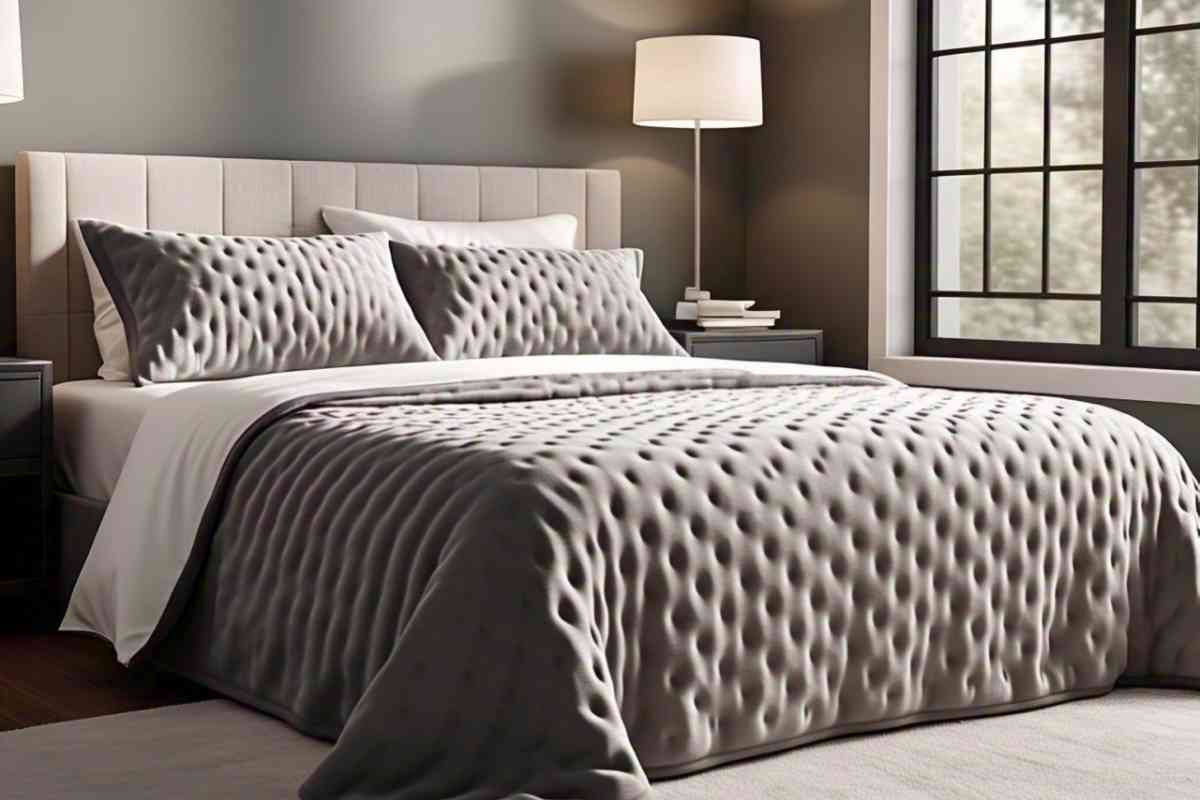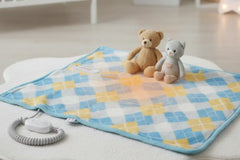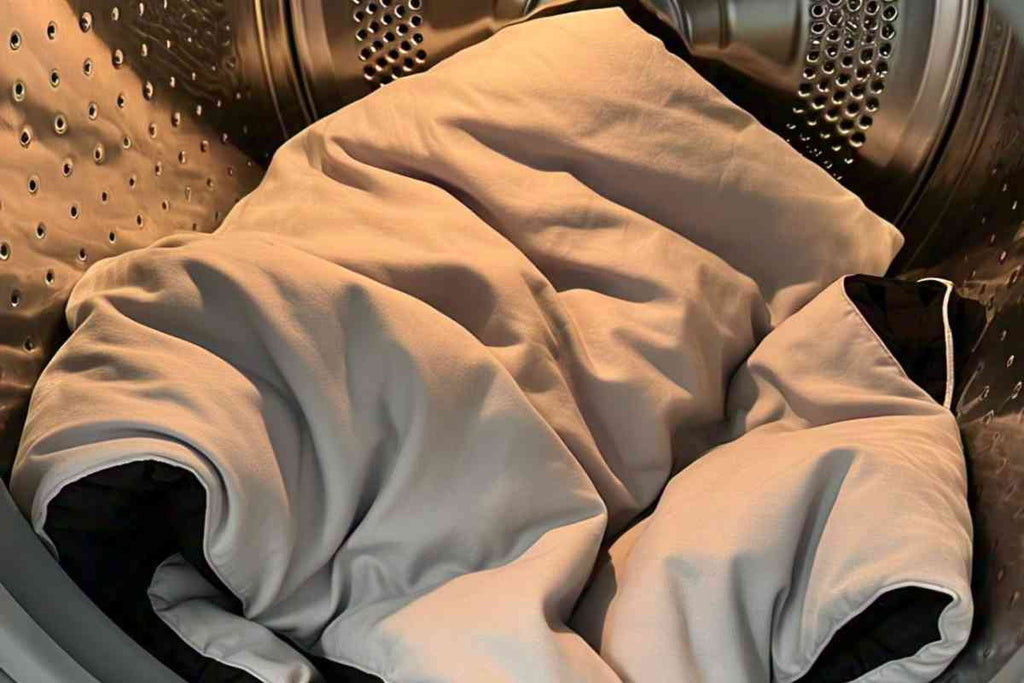How to Keep a Weighted Blanket From Sliding Off Bed?

Tired of your weighted blanket sliding off the bed every night? You’re not alone, and there’s a fix.
In this guide, you’ll learn the exact reasons it slips and how to stop it for good. From smart bedding choices to easy tricks, we’ve got you covered. Let’s keep that blanket right where it belongs.
Key Takeaways
-
Ensure your blanket fits your bed properly to avoid slipping.
-
Use anti-slip pads or grips to keep the blanket in place.
-
Secure the blanket with straps or ties for added stability.
-
Choose a heavier blanket for less movement during sleep.
-
Opt for non-slip materials or duvet covers to prevent slipping.
Common Reasons Weighted Blankets Slip Off the Bed
Improper Blanket Size or Fit (Too Big or Small for Your Bed)
- Too Big Blankets Slip Off Easily: A blanket that’s too large can have extra fabric that drags off the bed as you move, causing it to slip off during the night.
- Small Blankets Don’t Provide Enough Coverage: A blanket that’s too short or narrow won’t cover your body fully, leaving you uncomfortable or exposed while sleeping.
- Proper Sizing Prevents Slipping and Discomfort: Ensure the blanket fits your bed dimensions properly to avoid slipping and discomfort. Weighted blankets should be chosen based on your body size, not just mattress size. For example Twin: 38"x72", Full: 50"x72", Queen: 60"x80", King: 80"x86".
- Ideal Overhang Helps Keep the Blanket in Place: A blanket with a slight overhang, 4 to 6 inches on each side, helps keep it from slipping off while you sleep.

Uneven Weight Distribution (Causing Shifting of the Blanket)
- Uneven Weight Makes the Blanket Shift: When the weight is uneven, the blanket moves around as you sleep, causing it to shift off the bed.
- Heavier Side Pulls the Blanket Off: A heavier side of the blanket can drag it off the bed while you're sleeping, making it uncomfortable.
- Filling Shifts and Causes Discomfort: The filling inside the blanket, like beads or pellets, can shift and form clumps, leading to an uneven feel and discomfort.
Slippery Bed Sheets (Making It Hard to Keep the Blanket in Place)
Slippery bed sheets create less friction, allowing the blanket to slide more easily.
Consider using sheets with more grip, like cotton or flannel, which help keep the blanket in place. A mattress topper can also help stabilize your sheets, reducing their tendency to slip.

Movement During Sleep (Shifting the Blanket as You Toss and Turn)
If you toss and turn a lot during sleep, your blanket is likely to shift as well. The constant movement may cause the weighted blanket to fall off the bed or bunch up in one spot.
Heavier blankets may help reduce the urge to toss and turn, as the deep pressure stimulation can make you feel more relaxed.
Weak Anchor Points or Fasteners (Lack of Secure Attachment to the Bed)
Some weighted blankets come with fasteners or anchor points to secure them in place.
Fasteners, such as straps or loops, help keep the blanket securely attached to the bed or mattress, preventing it from slipping off. If these fasteners are weak or poorly designed, the blanket is likely to slip off.
Look for weighted blankets with secure attachment systems, like built-in straps or loops, which can be fastened to your bed frame or mattress.
Sleep Position Impact (How Your Sleep Style Affects Blanket Stability)
Your sleep position plays a huge role in whether your weighted blanket stays in place.
Sleeping on your back or stomach often results in more stability, while side sleepers or those who switch positions may experience more slippage.
A weighted blanket that’s too small or not evenly distributed will be more likely to shift during these movements.
Inconsistent Blanket Material (Different Textures Can Cause Slippage)
- Smooth Fabrics Make the Blanket Slip: Fabrics like satin or microfiber are smooth and don’t grip the bed well. This lack of texture makes it easier for the weighted blanket to slide off during the night.
- Textured Materials Help the Blanket Stay in Place: Materials such as cotton or linen have more texture, which increases friction with the bed. This helps the blanket stay in place, reducing the chances of slippage.
Summary
To prevent your weighted blanket from slipping off, make sure it fits your bed properly, has even weight distribution, and is paired with non-slip sheets. Also, consider your sleep position and use secure fasteners or textured covers to keep the blanket in place throughout the night.
How to Keep a Weighted Blanket From Sliding Off Bed?
Use Anti-Slip Pads or Grips to Keep Blanket from Sliding Around
Anti-slip pads are a simple solution to keep your weighted blanket from shifting during the night. These pads create friction between the blanket and your bed, helping it stay in place.
You can find specific anti-slip pads designed for weighted blankets, and they’re easy to apply.
Choose Fitted Sheets with Strong Elastic to Hold Bedding Firmly in Place
Fitted sheets with strong elastic are crucial for preventing your weighted blanket from sliding off the bed. The elastic helps keep the sheet tightly secured, even when you're tossing and turning.
Secure Weighted Blanket Using Ties or Straps Attached to the Bed
Straps or ties can be a game-changer when it comes to keeping your weighted blanket in place.
These ties attach your blanket to the bed or duvet cover, preventing any movement during the night.
If your blanket doesn’t already have loops, you can easily add your own by sewing 2-inch pieces of ribbon or thick string to the corners using a needle and thread or a sewing machine, making sure everything stays secure and in place.
Select a Heavier Weighted Blanket That Naturally Stays in Position Better
- Heavier Blankets Stay in Place Better: A heavier weighted blanket is naturally less likely to slide off your bed, thanks to the added weight keeping it in place even if you move around during the night.
- Choose the Right Weight for a Secure Fit: To keep your blanket secure, aim for a weight that’s about 10% of your body weight. Some people may prefer a range of 5% to 12%, depending on their comfort level.
Anchor Blanket Corners with Clips or Holders to Prevent Movement Overnight
Blanket clips are an excellent way to prevent your weighted blanket from shifting around at night.
Attach the clips to the corners of your blanket and secure them to the bed or duvet cover.
Ensure the clips are tight enough to prevent slippage but not so tight that they damage the fabric.
Use a Duvet Cover Designed with Non-Slip Fabric to Reduce Slipping
A duvet cover made with non-slip fabric is another effective way to keep your weighted blanket in place.
These covers are designed with materials that prevent the blanket from sliding off the bed, offering a hassle-free solution.
Position the Weighted Blanket at the Foot of the Bed for Stability
Positioning your weighted blanket at the foot of the bed can help improve stability and prevent it from sliding.
When placed near the foot, the blanket has more support and is less likely to shift during the night.
Folding the end of the blanket under itself creates a thicker, heavier edge that resists sliding off the bed, giving it even more grip and keeping it in place as you sleep.
Summary
To keep your weighted blanket from sliding off the bed, use anti-slip pads, strong fitted sheets, ties, clips, or a non-slip duvet cover. Position it smartly or choose a heavier blanket. These easy fixes help you sleep comfortably without constant readjustments.
What to Look For in a Weighted Blanket That Won’t Slide?
Choose Non-Slip Materials to Prevent Slipping on Smooth Sheets
Non-slip materials like microfiber, minky, or fleece create natural friction to help the blanket stay put. These fabrics grip better, making it harder for the blanket to move around.
Go for Even Weight Distribution to Avoid Blanket Shifting
Good blankets use small stitched sections or pockets to keep the weight from moving around.
A well-balanced blanket won’t shift much, helping it stay snugly in place all night. Glass beads provide a smoother, more consistent weight distribution compared to plastic pellets, which can sometimes feel clumpy, ensuring the blanket delivers even pressure throughout without any lumps.
Opt for Quilted Construction to Keep Weight Anchored
- Quilted Construction Prevents Shifting: Stitched patterns in quilted weighted blankets secure the inner fill in small sections, preventing any shifting or movement that could pull the blanket off your bed.
- Baffle Box Quilts Provide Even Weight Distribution: The internal walls in baffle box quilting help spread the weight evenly across the blanket, keeping it balanced throughout the night.
- Stay Stable and Comfortable All Night: Both quilted and baffle box designs ensure the fill stays in place, offering you a stable and comfortable night’s sleep.
Look for Elastic Straps or Fasteners to Secure the Blanket to Your Mattress
Some weighted blankets come with elastic straps or ties that attach directly to your bed or duvet cover.
These additions help keep the blanket from sliding off, especially if you move around in your sleep.
Pick the Right Size for Your Bed to Avoid Overhang and Drag
A blanket that hangs too far off the sides of your bed can drag and slide off during the night.
Measure your mattress before buying, and aim for a blanket that fits the top of your bed without much overhang.
Check for Anti-Slip Backing to Add Extra Grip on Your Bed Surface
- Anti-Slip Backing Keeps the Blanket in Place: Anti-slip backing, often made of rubber-like dots or textured fabric, grips the bed surface and prevents the blanket from sliding around.
- Built-In Grips Hold the Blanket Firmly: Some blankets have tiny rubberized dots on the underside, which help keep the blanket from shifting, so no extra pads are needed.
Summary
To stop your weighted blanket from sliding, choose non-slip fabrics, balanced weight, quilted design, and secure straps. Make sure it fits your bed, and look for anti-slip backing or add a rug pad. These simple tips help your blanket stay put all night.

| Feature | Helps Prevent Sliding? |
| Non-slip materials | ✅ Yes |
| Even weight distribution | ✅ Yes |
| Quilted construction | ✅ Yes |
| Elastic straps or fasteners | ✅ Yes |
| Oversized blanket | ❌ No |
| Anti-slip backing | ✅ Yes |
❌ No |
FAQs
Does Adding Bed Rails Help Keep the Blanket On?
Bed rails can help keep a weighted blanket from slipping off, but they may not fully secure the corners. While designed for overall stability, they aren’t the best solution for preventing blanket movement. Adjustable or portable bed rails offer more support.
Can Mattress Pads Help Prevent Blanket Movement?
A mattress pad can help keep your weighted blanket in place by improving friction between the blanket and the bed, preventing unwanted movement. Mattress pads with non-slip features, such as memory foam or quilted pads, work well to keep your blanket secure.
Mattress Materials Make Weighted Blanket Sliding Worse?
The material of your mattress affects the blanket’s stability. Memory foam creates more friction, while smoother surfaces like innerspring mattresses allow the blanket to slide. Firmer mattresses help keep the blanket in place better than softer ones.
Are There Weighted Blankets With Anti-Slip Features?
Many weighted blankets now come with anti-slip features like silicone beads or textured backing, which grip the sheets or mattress and prevent movement.
Can a Mattress Topper Prevent Blanket Slippage?
A mattress topper, especially a memory foam topper, can help prevent your weighted blanket from sliding off by creating a firmer, more stable surface and adding extra grip.





